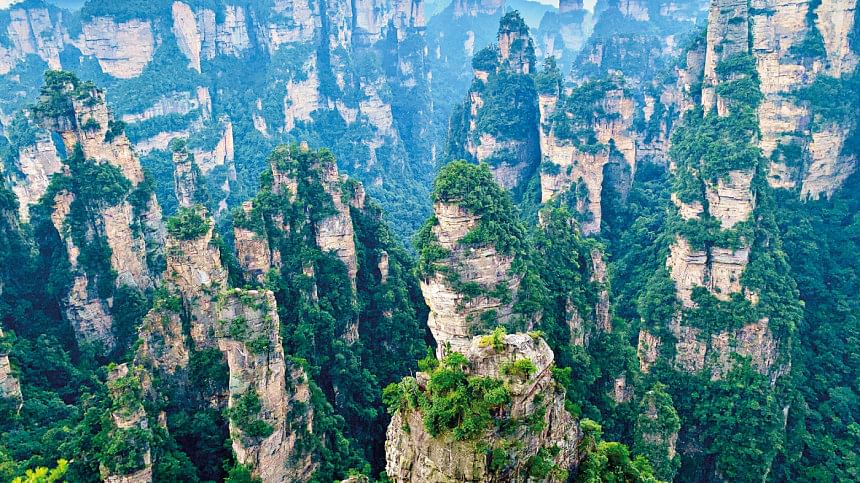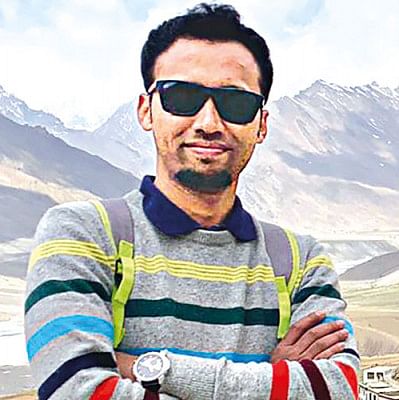Amazing Zhangjiajie Exploring the Avatar Mountains


Located in the northwest corner of China's Hunan province lies the sandstone marvel of Zhangjiajie, part of the greater Wulingyuan Scenic and Historic Area where peculiar rock spears rise high above the forest ground.
I wanted to visit this place after watching James Cameron's Avatar. The film's computer-generated imagery of the alien land was based on the iconic sandstone spires of Zhangjiajie National Forest Park. It is also known as the Grand Canyon of China.
This park also has the world's highest outdoor elevator, the longest cable car, and some terrifying cliff-hanging glass walkways. All these attractions make Zhangjiajie a unique travel destination for thrill seekers and nature lovers.
Let me share with you the experiences I had during my 3-day Zhangjiajie trip just before the Covid pandemic.
After landing at Zhangjiajie Airport in the middle of the night from Guangzhou, three of my friends and I spent the rest of it in a hotel in the city centre. Early morning, we left for Tianmen Shan or the 'Heaven's Gate Mountain. Tianmen Mountain, which is only 8 kilometres from the city, stands tall at about 5,000 feet.
We took the cableway from the city centre. The 25,458-foot-long world's longest cableway gains 4000 feet on its way to the mountain.
The half-hour cable car journey was simply breathtaking. We witnessed a spectacular sunrise. We saw the famous 99 Bends Road winding up the mountain underneath us. The 360-degree views of sky-high rock pillars and the forest's lush green beneath were magnificent.
When we reached our destination, it was covered in light fog. The misty, mysterious environment momentarily made me feel I was in Pandora!
Tianmen mountaintop is girdled by a daredevil walkway suspending at 4,700 feet above sea level. While most of it is made of concrete, one 200-foot-long part has floors made of see-through glasses. We had a good time roaming around and experiencing an adrenaline-filled walk on the cliff-hanging walkway and skywalk.
Next, we visited the Tianmenshan Temple. This temple, built in 870 AD by the Tang Dynasty, is located on top of the mountain offering a panoramic view of the valley. It claims to be the Buddhist centre of Western Hunan.
Our next site was the "gateway to heaven", a natural cave which is the main tourist draw of the area. To see it, we had to descend. On the way, we discovered one of the craziest things: escalators. Yes, they did build escalators into the mountain to transport people quickly and comfortably up and down. I suppose you can only find these in China!
At about 5,000 feet above sea level, Tianmen Cave is the highest naturally formed arch in the world.
To reach the landmark, visitors must walk up 999 steps on the "stairway to heaven." Nine is a lucky number in Chinese numerology, representing good fortune and eternity.
The cave itself is about 430 feet tall and 190 feet wide. It used to be a fairly ordinary cave until the year 263 AD when one side of the mountain's cliff collapsed and created the portal to heaven.
After taking the escalators and descending the 999 steps, we arrived at the bottom of Tianmen Cave. The view of the staircase and the inexplicable hole in the mountain is hard to explain in words.
We returned to Zhangjiajie city using the "99 bends road", which, as its name suggests, has 99 sharp bends, and is one of the most picturesque mountain roads in Asia.
In the evening, we left our hotel for Wulingyuan Scenic Area. Hotels with basic amenities are available inside the park. We checked in at a hotel and spent most of the night exploring the area.
The next morning, we went to the National Forest Park ticket station around 7:00 am as it gets busy later in the day. We took a bus from the entrance National Park'. It dropped us on the foot of the Bailong Elevator, recognized by Guinness World Records as the world's tallest outdoor lift.
Bailong Elevator is the most convenient way up to Yuanjiajie Scenic Area to see the Avatar Mountains. It took only 1 minute 28 seconds to reach the top of the 1076-foot-long elevator shaft. Otherwise, it might take around 3 hours to reach the mountain top if you choose to hike.
After reaching the upper station, we walked to Yuanjiajie Scenic Area, where dozens of foliage-covered vertical stone columns rise into the sky. This unique lanscape inspired the floating Hallelujah Mountains of Pandora in the film Avatar.
After spending some time there, we took the sightseeing bus to Tianzi Mountain, which provides stunning views of peaks. It is known as the Monarch of the Peak Forest. At the top of the mountain, visitors can see the full extent of the Wulingyuan Scenic Area.
The whole area was formed by sedimentary rocks 318 million years ago. Those rocks, eroded by the water and wind, slowly turned into quartz stones and formed those peaks in the scenic area.
Later, we took the cable car to get down to the park entrance. We went back to our hotel in Wulingyuan to spend the night.
The next morning, we went to the Zhangjiajie Grand Canyon by taking a coach from the Wulingyuan bus station to experience an unforgettable walk.
Imagine walking through the clouds on a bridge with a glass floor nearly 1,000 feet (980 feet to be exact) up in the air while you can see the deep canyon under your feet! I bet you will think twice before setting foot on it.
It took a lot of courage to step onto the Zhangjiajie Glass Bridge, the longest and highest glass-bottom bridge in the world when it opened in 2016.
The 1,410 feet long bridge is inside Zhangjiajie Grand Canyon, which takes about a 40-minute ride from Wulingyuan.
With alien-looking mountains, rivers, and caves, this whole area looked like a charming landscape painting. The fresh air, emerald-coloured lake, and green mountains along with its rich biodiversity will surely make you feel connected with nature.
After crossing the glass bridge, we took 2300 feet long Sky Ladder Plank Road to get down. The slope of this wooden stair is very steep and narrow, so you will need strong legs to take on this path. However, you surelywill miss the beauty of the path if you take the zip line.
At the bottom of the valley, a wooden path alongside a quiet and clear stream will welcome you. The serenity around while walking there will amaze you for sure.
Later, we visited popular sites like the Momo Cave, the Holy Spring Lake and more while appreciating the stunning and well-preserved natural beauties.
The last place we visited was Baofeng Lake, a turquoise-coloured water body surrounded by graceful mountains. It is an artificial freshwater lake created in the 1970s by building a dam. At the lake, you can take a boat ride to feel relaxed after hiking in the nearby mountains.
With alien-looking mountains, rivers, and caves, this whole area looked like a charming painting. The fresh air, emerald-coloured lake, and green mountains along with its rich biodiversity will surely make you feel connected with nature.
We took a city bus to go to our hotel. We had to leave for Beijing at night.
I have to admit that, so far, I haven't seen anything like Zhangjiajie. It's simply otherworldly.
It doesn't matter how many times you have seen pictures of this place. Once you visit the area, you will be amazed, guaranteed.
When to go
The best time would probably be to travel between November and April. This time ensures clear weather, though the temperature might be a bit low (around 8°C). From my experience the best month is April. Must Ignore Chinese Holidays.
How to go
Option 1: You can take a high-speed train from any major city in China to Changsha. Then take a train to Zhangjiajie city (about 6 hours).
Option 2: you can fly from Dhaka to Guangzhou (as we did). Then take another flight from Guangzhou to Zhangjiajie Hehua Airport.
Expenditures
Going in a group saves money. The 3-day trip, inclusive of all costs, may cost you around 70,000 BDT each person.

 For all latest news, follow The Daily Star's Google News channel.
For all latest news, follow The Daily Star's Google News channel. 




Comments